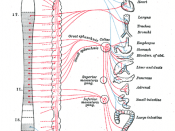HUMAN BODY'S PHYSIOLOGICAL RESPONSE TO A STRESSOR. EVALUATE TECHNIQUES THAT CAN BE USED AS COPING STRATEGIES - STRESS MANAGEMENT TECHNIQUES Stress can be defined as any threat, assumed or direct, to well being. In this essay we will focus on the physiological response to a stressor and evaluate ways of coping or managing symptoms since we cannot eliminate stress completely from our lives.
Stress comes in two forms, acute (short-term) and chronic (long-term) and can be experienced either externally or internally. External stressors may include pain, extreme temperature changes, poor working conditions or unhappy, unfulfilling relationships. Internal stressors may include illnesses, infections or worry. Acute stress is the physiological reaction to an immediate threat. The term "fight or flight" response is used as the body readies itself to respond to perceived danger.
Research carried out by Selye (1936, 1950) on rats led to his conclusion that when exposed to unpleasant situations, animals react in the same way.
This response is known as the General Adaption Syndrome or GAS model which has three distinct stages, alarm, resistance and exhaustion. Once the body has perceived danger or threat it responds. The sympathetic branch of the autonomic nervous system (ANS) activates the adrenal medulla on top of the kidney's to release adrenaline and noradrenaline. The heart rate increases along with breathing rate, blood flow increases priming muscles for action, red and white blood cells are discharged from the spleen so blood can transport more oxygen. The body becomes sweaty or clammy as blood is diverted away from the skin to the heart and muscle tissue, the scalp also tightens and hair seems to stand on end. Digestive processes slow down and urinary and bowel function ceases temporarily. This is stage 1 of the GAS or SAM system. If threat cannot be...


